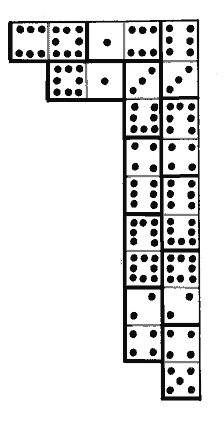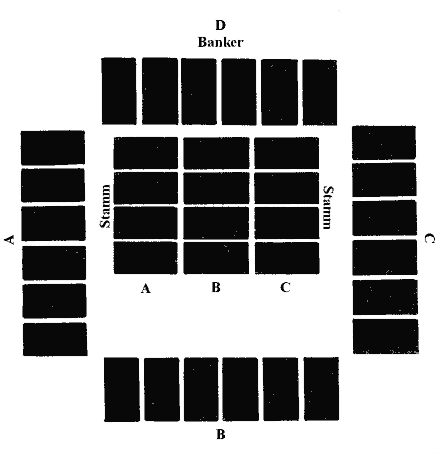

Austrian domino games traditionally use a double eight set of 45 tiles. The domino chapter of Verstand und Glück im Bunde (F. Tendler, Vienna, 1830) describes a draw game for two to six players with this set, and according to Domino in vielen Spielarten by Fritz Beck (Pechans Perlen Reihe, Vienna, 1960) this was still the case in the mid 20th century. About 90% of Beck's book is devoted to games with the [8-8] set, usually reduced to 36 tiles by discarding all the doubles, and there are only a few pages at the end describing games with the [6-6] set. A report of these [8-8] games in English, probably based on Beck, appears in Domino Games and Puzzles by K. W. H. Leeflang (Amsterdam 1972; New York 1975).
According to Beck, dominoes in Austria are normally sold as double eight sets with 45 tiles. That was in 1960: I don't know whether it is still true today, but Alexey Lobashev tells me that he has seen 45-tile sets on sale in Hungary. For the game the nine doubles are normally removed, leaving 36 tiles. If an original double eight set is not available, this set can be made from a double nine set by removing 19 tiles.
Two or three players can play a draw game: two players get 8 or 9 each tiles; three players get 7 tiles each.
Four players play as individuals with 7 or 8 tiles each. This is a block game in which the boneyard (Stamm or Talon) of 8 or 12 tiles is not used. Three can also play a block game taking 8 or 9 tiles each, and two players take 11 or 12 each.
 The Play
The PlayThe tableau is not played in a line, but as a double line, with the matching end placed on the side of the tile to which it matches. It looks like a row of bricks - the illustration to the right is from Beck's Domino in vielen Spielarten.
When playing a draw game, a player who is unable to play draws tile from the boneyard until able to do so. It is sometimes agreed that a player can draw only up to three tiles in this way, and that if unable to play after drawing three tiles the player must pass.
When a block game is played, a player who cannot play simply passes and the undealt tiles remain unused and unknown.
For the first round the first player is the holder of the heaviest tile - the [8-7] if it is in play, otherwise the [8-6] and so on. The winner of the each round leads in the next round.
The first player to domino wins. If the game blocks, the player with the fewer total pips on the tiles in his hand wins. If players tie for lowest, then there is no winner and the player who set the last tile leads the next round.
According to Beck this four-player variant was considered a gambling game under Austrian law and therefore officially prohibited. He nevertheless devotes 20 pages to it, with advice on play and an example game. It is a block game using 36 tiles (no doubles) in which each player takes 6 tiles, leaving a Stamm of 12 tiles.
Before the game, one of the four players is chosen as the banker for the session, and the minimum and maximum stake must be agreed. It seems that a ratio of 3:1 between the maximum and minimum is about right. A small difference between maximum and minimum gives an advantage to the banker and a large difference an advantage to the other players. After shuffling, the players take their six tiles each and the banker lays out the Stamm in three columns of four tiles as shown in the diagram, where player D is the banker:

These undealt tiles of the Stamm are not used in the game, but provide the positions where the players A, B and C place their bets. Note that it appears from the diagram - taken from Beck's book - that this game was sometimes played counter-clockwise. Beck recommends that the direction of play be reversed from time to time, for example after every five or ten games, so that a player is not always playing immediately after the same opponent.
Each of the players other than the banker must place a stake before his third turn in the game. The player chooses the amount of the stake, depending on what he considers are his chances of winning, but it must be not less than the agreed minimum and not more than the maximum. At the end of the play, the winner retrieves his stake and is paid two and a half times his stake by the banker. The banker collects the stakes of the other players. If the banker wins, he collects all the players' stakes. If a player other than the banker wins, this player must place his stake at the start of the following game, before setting his first tile.
Example. With a minimum stake of 2 and a maximum of 6, player A stakes 4, player B 2 and player C 6. If A wins he keeps his 4 and receives 10 from D so the net result is A: +10, B: -2, C: -6, D: -2. If B wins the result is A: -4, B: +5, C: -6, D: +5. If C wins the result is A: -4, B: -2, C: +15, D: -9. If D wins the result is A: -4, B: -2, C: -6, D: +12.
If the game is blocked, the player with the lowest pip count in his unplayed tiles wins as usual. If there is a tie for lowest pip count, the players' stakes remain on the table. In the next game, players may add to their stakes (up to the maximum) but cannot reduce them.
Some play that any player may ask to increase his stake any time until his fourth turn, but the banker is free to accept or refuse such a request.
This game was often played with spectators, who must sit so that they can only see one players hand. Spectators are not allowed to comment on or interfere with the play in any way, but can ask to place a bet on the player they are watching to win. The banker is not obliged to accept spectators' bets, and may choose to accept some bets and not others.
Variation. Buki was often played with seven tiles each and a Stamm of 8 tiles. With fewer tiles out of play there is more scope for skill. The banker places the Stamm in a single row of eight tiles. His neighbours place their bets at the ends of the row nearest them and the player opposite the banker places his bet in the middle of the row. The rules of play and payments are exactly the same as for Buki with six tiles.
This is another block game for four players using 36 tiles and taking seven tiles each. Before the game each player contributes an equal stake to the pool (Pulle). At the end of the play, whether blocked or not, all players count the pip total on their unplayed tiles and add this to their running score. A player whose score is more than 100 is eliminated from the game, and the last surviving player collects contents of the pool. Note that if you have 100 you are still alive - only a player with 101 or more is knocked out.
That is the basic game, but it is complicated by the possibility of buying back (zurückkaufen). After any game, a player may pay half the initial stake to the pot, and his score is then adjusted to be equal to the middle score of the other three players. This is possible even for a player whose score has just gone over 100. For example, if after a game the scores are A:107, B:94, C: 68, D:50, A can either drop out of the game or "buy back" for a half stake, reducing his score to 68. At this point B could also pay a half stake into the pool to reduce his score to 68 as well. If the other players' scores are all equal, then a player who buys back gets a score that is one greater - for example if the scores are 99:70:70:70 then the player with 99 will have his score reduced to 71 if he buys back.
It can happen that a blocked game ends with everyone having 101 or more points. This is known as a "broken pool" (gesprengte Pulle). Everyone's score is set back to zero, everyone pays the initial stake into the pool again, and you carry on playing.
Often the game is played in such a way that as well as playing for the pool the winner of each individual game wins a certain amount from each of the other players. In this case the winner of a blocked game wins half as much as a player who dominoes (plays his last tile). Beck gives an example in which each player pays 3.00 to the pool initially, buying back costs 1.50 to the pool, and the winner of each game receives 1.00 from each opponent, or 0.50 each if the game is blocked. In the case of a blocked game where the players tie for lowest score, there is no payment for the game, and the players' pip totals are not added to their running scores.
The German Wikipedia page Bukidomino has more information on the history of Buki and an illustration of a game in progress.